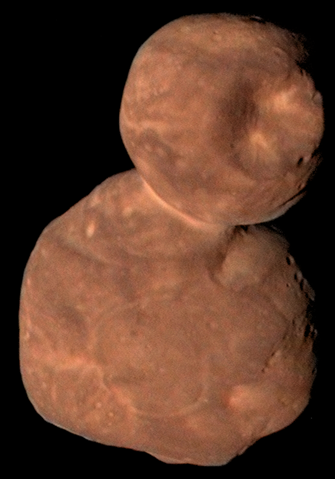Skynotes: March 2022
Upcoming events
Arrokoth gives insights and gets names
Kuiper Belt object Arrokoth, which had a fly-by visit by New Horizons probe in 2019, is giving fresh clues into how these far flung objects may have formed.
Arrokoth, designated 2014 MU69 and informally dubbed Ultima Thule, is a 35 km-sized icy double-lobed world consisting of two discs joined at a narrow neck. This contact binary orbits the sun in a little under 300 years and lies over 6 billion km from Earth in the frigid realm of objects well beyond Pluto. It likely formed as two objects slowly and gently joined under their mutual gravitational attraction.
It is considered one of many small objects or ‘planetisimals’ that formed from a collapsing cloud of material. Although Arrokoth appears to be 4 billion years old, under the right conditions it could have joined with others to form a protoplanet and perhaps something larger. New Horizons mission data, from a space probe that just keeps on giving, is still being analysed providing new evidence for these processes.
The unusual object’s remarkable red colour is believed to derive from carbon-containing (organic) molecules mixed with methane ice.
Names have now been given to some of its more obvious surface areas. Arrokoth itself means ”sky” in the Powhatan/Algonquin Native American language, and other features now bear names from Mayan, Bengali, Sanskit, Nepali, Malayam, Sinhalese, and Tamil traditions, among others.
This new world, completely unknown to humanity before 2014 and a mere speck of light before New Horizons visit in 2019, now has representation from many cultures.
See
Autumn Equinox
This month we have almost equal lengths of day and night – the equinox – when Earth’s axis leans neither toward nor away from the sun. We are at the midway point between summer and winter solstices (see Planets below).
Learn more at
Melbourne Sun times
| Date | Rise | Set | Day length | Solar noon* |
|---|---|---|---|---|
| Tue 1st | 7:04 | 8:00 | 12:56 hrs | 1:32 |
| Fri 11th | 7:14 | 7:45 | 12:31 hrs | 1.30 |
| Mon 21st | 7:23 | 7:30 | 12:07 hrs | 1:27 |
| Thu 31st | 7:32 | 7:15 | 11:42 hrs | 1:24 |
*When the sun is at its highest, crossing the meridian or local longitude.
Moon phases
| Phase | Date |
|---|---|
| New Moon | Thu 3rd |
| First Quarter | Thu 10th |
| Full Moon | Fri 18th |
| Third Quarter | Fri 25th |
Moon distances
Moon apogee (furthest from Earth) is on Fri 11th at 404,268 km.
Moon perigee (closest to Earth) is on Sun 24th at 369,760 km
Planets
Mercury is still visible before dawn rising in the east from around 5.10am early in the month and then a little later each morning. By late March it will lie too close to the sun to be seen.
Venus is very bright this month living up to its reputation as the third brightest in the sky after the sun and moon. It is the ‘morning star’ rising from around 3.30am and will be clearly visible well into the early dawn light.
Earth’s southern hemisphere experiences the Autumn Equinox on Monday 21st with the Sun rising almost due east and setting virtually due west. Equinox comes from ancient Latin aequinoctium (equal night) and medieval equinoxium to our modern term. On the 20th the Earth’s axis at a fixed tilt of 23.5 degrees will not be leaning away from the sun as it does in winter, nor towards the sun as in summer. However, for Melbourne’s latitude day and night are almost exactly equal in length a few days later on Wednesday 24th. This four-day delay is because the atmosphere bends or refracts light from the sun allowing us to see the sun a little before it physically rises, and for a short time after it has actually set.
Over the next three months the sun’s daily path across the sky shifts northward a little each day until we arrive at the mid-year Winter Solstice. At that time our planet’s axis will lean the southern hemisphere away from the sun.
Mars is close to Venus in the early morning rising shortly after 3am but being fainter the Red Planet will be lost in the dawn light well before Venus.
Jupiter has moved behind the sun but will reappear again late in the month when it will rise in the east around 6:15am and be visible for a short time before dawn.
Saturn will also reappear this month before dawn. Early in the month it will rise in the east from 5am then a little earlier each morning. By the end of March it will visible from around 3:50am.
International Space Station
ISS orbits every 90 minutes at an average distance of 400km appearing like a bright star moving slowly across the night sky. Here are some bright passes expected this month over Melbourne.
Evening
- Wed 2 Mar 9:50pm – 9:53pm South-West to West-South-East
- Thu 3 Mar 9:01pm – 9:06pm South-West to East-North-East
Morning
- Wed 23 Mar 6:25am – 6:31am North-West to East-South-East
- Fri 25 Mar 6:25am – 6:31am West to South-East
Heavens Above gives predictions for visible passes of space stations and major satellites, live sky views and 3D visualisations. Be sure to first enter your location under ‘Configuration’.
Meteors
There are two small showers this month that occur near the South Celestial Pole (SCP). If you extend the long arm of the Southern Cross 4.5 times that will bring you very close to the SCP. The gamma Normids is due to peak around the 14th centred on the yellow giant star Gamma Normae in the constellation of Norma, the level. The other is the delta Pavonids from the 21st peaking in early April in Pavo, the peacock. Meteor showers are best seen from midnight to dawn and from a location well away from city lights.
Stars and constellations
In the north and north-west
The constellation of Orion the hunter can be found in the north-west after sunset. From the southern hemisphere he is upside down. Look for three bright stars in a line to form Orion’s Belt which also form the base of The Saucepan from a southern perspective. In the sword or scabbard that ‘hangs’ from his belt, which is also the saucepan’s handle, is the Orion nebula (M42, the 42nd item in Charles Messier’s famous list of deep space objects). Directly below is one of his shoulders, the red supergiant star Betelguese which has an obvious orange-red colour, and diagonally across and above Orion’s belt is the blue-giant star Rigel that marks one of his feet.
To the left and lower down is Taurus the bull, its head an inverted V. This pattern forms the open grouping of stars known as the Hyades. Another easily recognizable red-giant star Aldebaran, some 65 light years from us, lies at the top end of the open V.
Below Taurus’s head or Hyades is the Pleiades Cluster (M45). The beautiful cluster at 444 light years from us contains over 1000 stars including a small number of very bright stars. You should test your eyesight and observing skills by counting the number. For some stargazing cultures it represents a group of women and is often referred to as the Seven Sisters. In New Zealand-Aotearoa it is Matariki, its appearance marking the start of the Maori New Year.
Low in the north can also be seen Castor and Pollux, the principal stars for Gemini the twins.
High in the north is the brightest star in our night sky, Sirius in Canis Major (greater dog) and directly below is Procyon in Canis Minor (lesser dog), both of which are Orion’s hunting dogs.
In the north-east
Low in the north-east we can now see the hook of stars, like an inverted question mark, that forms the head and mane of Leo the lion with the bright star Regulus.
In the south-east
Easy to spot is the Southern Cross or Crux lying on its side with Alpha and Beta Centauri (the Two Pointers) below. If you can see the broad band of distant stars of the Milky Way that spreads across the sky from south to north, you will also be able to spot the dark dust cloud known as the Coal Sack that sits beside the Southern Cross.
In the south-west
Out on their own, but best seen away from city lights, are the Large and Small Magellanic Clouds, our galaxy’s nearest neighbours at 163,000 and 206,000 light years away respectively. Look for two fuzzy patches in the sky directly opposite the Southern Cross which lies in the south-east. We are fortunate to see them all year round. From equivalent latitudes in the northern hemisphere such as Europe, North America, China, Japan or Korea, they cannot be seen. There is a tenuous connection between our galaxy and its neighbours, and it would seem they are being drawn in destined to join our galaxy in two and a half billion years.
On this day
1st 1966, Venera 3 (USSR) crash lands on Venus as first probe to land on a planet.
1st 1982, Venera 13 (USSR) sends the first colour pictures of the surface of Venus and continues transmitting data for 2 hours, well beyond the 30 minute expectation.
2nd 1972, Pioneer 10 (USA) probe launches to the outer solar system.
3rd 1969, Apollo 9 (USA) tests lunar module in Earth orbit for eventual moon landings.
4th 1979, Voyager 1 (USA) discovers the faint rings of Jupiter, with Voyager 2 taking further images four months later during its own fly-by of the giant planet.
5th 1590, Tycho Brahe discovers a comet and shows that comets are further away than the Moon.
5th 1979, two probes and a satellite are affected by ‘gamma ray bursts’ leading to study of these high energy phenomena.
6th 1986, Vega 1 (USSR) makes the first flyby of Comet Halley and returns the first close-up images of a comet.
9th 1934, birth of first human into space, Soviet cosmonaut Yuri Gagarin.
11th 1977, the rings of Uranus are discovered as the planet eclipses a distant star.
13th 1781, Uranus is discovered by Sir William Herschel (UK).
14th 1879, birth of Albert Einstein famous for photo-electric effect, relativity, and letter to US President Roosevelt on the power and destructive potential of the atom.
17th 1958, first solar powered satellite, Vanguard 1 (USA), is launched.
18th 1965, Aleksei Leonov (USSR) carries out the first spacewalk.
20th 1916, Einstein publishes his theory of gravity, the General Theory of Relativity.
23rd 2001, Russian (former USSR) space station Mir (‘Peace’) is destroyed in its planned re-entry to Earth’s atmosphere.
23rd 1912, birth of Werner von Braun, famous for leading German rocketry in World War 2, and a key figure in US space program until the 1970s.
24th 1965, Ranger 9 (USA), sends first television of the moon before crash landing.
25th 1655, Christiaan Huygens discovers Titan, the largest moon of Saturn.
27th 1969, Mariner 7 (USA) is launched to Mars.
29th 1974, first fly-by of Mercury by Mariner 10 (USA).
30th 240BC, closest approach to the Sun (perihelion) in historical records of what is now called Comet Halley.
31st 1966, Luna 10 (USSR) becomes the first probe to orbit the moon.

